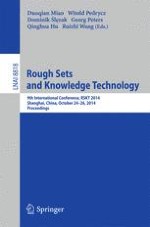This book constitutes the thoroughly refereed conference proceedings of the 9th International Conference on Rough Sets and Knowledge Technology, RSKT 2014, held in Shanghai, China, in October 2014. The 70 papers presented were carefully reviewed and selected from 162 submissions. The papers in this volume cover topics such as foundations and generalizations of rough sets, attribute reduction and feature selection, applications of rough sets, intelligent systems and applications, knowledge technology, domain-oriented data-driven data mining, uncertainty in granular computing, advances in granular computing, big data to wise decisions, rough set theory, and three-way decisions, uncertainty, and granular computing.
